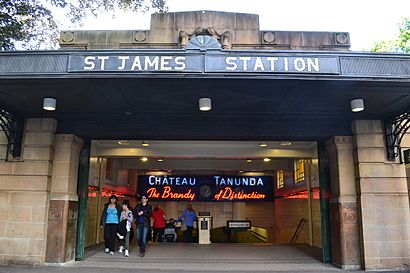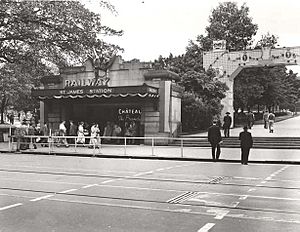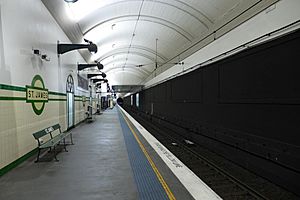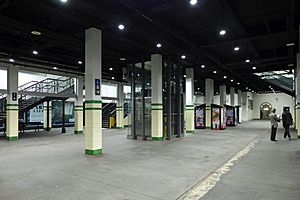St James railway station, Sydney facts for kids
Quick facts for kids
St James
|
|||||||||||||||||||||
|---|---|---|---|---|---|---|---|---|---|---|---|---|---|---|---|---|---|---|---|---|---|

Elizabeth Street entrance in June 2011
|
|||||||||||||||||||||
| Location | Elizabeth Street, Sydney central business district, City of Sydney, New South Wales, Australia | ||||||||||||||||||||
| Coordinates | 33°52′13″S 151°12′43″E / 33.8702°S 151.2120°E | ||||||||||||||||||||
| Owned by | Transport Asset Holding Entity | ||||||||||||||||||||
| Operated by | Sydney Trains | ||||||||||||||||||||
| Line(s) | City Circle | ||||||||||||||||||||
| Distance | 4.4 km (2.7 mi) from Central (clockwise) | ||||||||||||||||||||
| Platforms | 2 (1 island) | ||||||||||||||||||||
| Tracks | 2 | ||||||||||||||||||||
| Connections | Bus | ||||||||||||||||||||
| Construction | |||||||||||||||||||||
| Structure type | Underground | ||||||||||||||||||||
| Disabled access | Yes | ||||||||||||||||||||
| Architect |
|
||||||||||||||||||||
| Architectural style | Inter-War Stripped Classical | ||||||||||||||||||||
| Other information | |||||||||||||||||||||
| Status | Staffed | ||||||||||||||||||||
| Station code | STJ | ||||||||||||||||||||
| Website | Transport for NSW | ||||||||||||||||||||
| History | |||||||||||||||||||||
| Opened | 20 December 1926 | ||||||||||||||||||||
| Electrified | Yes | ||||||||||||||||||||
| Traffic | |||||||||||||||||||||
| Passengers (2018) | 23,550 (daily) (Sydney Trains, NSW TrainLink) | ||||||||||||||||||||
| Services | |||||||||||||||||||||
|
|||||||||||||||||||||
| Official name | St. James Railway Station group; St James Railway Station | ||||||||||||||||||||
| Type | State heritage (complex / group) | ||||||||||||||||||||
| Designated | 2 April 1999 | ||||||||||||||||||||
| Reference no. | 1248 | ||||||||||||||||||||
| Type | Railway Platform/ Station | ||||||||||||||||||||
| Category | Transport - Rail | ||||||||||||||||||||
| Builders | Department of Railways | ||||||||||||||||||||
|
|||||||||||||||||||||
St James railway station is a historic underground train station in Sydney, Australia. It is located near Hyde Park in the city centre. The station is part of the City Circle train line. It serves Sydney Trains services like the T2 Inner West & Leppington, T3 Bankstown, and T8 Airport & South lines. The station is named after the nearby St James' Church. It also provides a direct link to the Sydney Airport train stations. St James station was added to the New South Wales State Heritage Register in 1999. This means it is a very important historical site.
Contents
History of St James Station
St James station was part of a big plan for Sydney's trains called the Bradfield Plan. It was meant to be a major hub where different train lines would meet. The original plan included train lines going in four directions. However, this full plan was never finished.
Building the Station Platforms
Four platforms were built at the station. But two of these, the inner platforms, were never used for trains. They were meant for new lines to the eastern and western suburbs. These lines were never built as planned. In the 1990s, the space between the two inner platforms was filled in. This created the single, large platform you see today.
Station Design and Opening
The station was designed by George McRae, a government architect. It shows a style called Inter-War Stripped Classical architecture. This style was influenced by Art Deco. A cool feature is an old neon sign from the 1930s. It advertises "Chateau Tanunda Brandy" and is at the Elizabeth Street entrance. St James station is like its twin, Museum station. Both opened at the same time and use a similar round design for their signs, like the London Underground.
St James station opened on December 20, 1926. It was part of the new eastern city line from Central. For 30 years, St James was the end of the line for trains from Bankstown, East Hills, and Illawarra. Trains would drop off passengers, then move to a side track. From there, they would reverse direction and pick up new passengers on the other platform.
Completing the City Circle
The full City Circle train loop was not finished until 30 years after St James opened. Building the line that connected Wynyard and St James through Circular Quay was difficult. Work stopped during World War II and was slow afterwards. The Circular Quay station and its tracks were finally finished in 1956. This allowed trains to travel in a full circle through the city. They no longer had to stop and turn around at St James.
Because of this, the special turning facilities at St James were not needed as much. The signal box, which controlled the tracks, was used until 1990. It was then closed because asbestos was found. The old signals and side tracks were later removed.
In 2010, a lift was added between the platform and the concourse. Later, another lift connected the concourse to the street. This made the station easier for everyone to use.
Exploring the Tunnels
St James station is famous for its abandoned tunnels. These tunnels were built as "stubs" for the planned eastern and western train lines. This was done so that future work on these lines would not stop the station from running. The tunnels go quite a distance from the station. To the north, a double-track tunnel goes about 250 metres under Macquarie Street. To the south, two single-track tunnels reach Whitlam Square.
Mushroom Farm in the Tunnels
From 1933 to 1934, one of the tunnels was used as an experimental mushroom farm. A person named Raymond Mas grew about 4,500 kilograms (10,000 lb) of mushrooms each month!
World War II Use
During World War II, the southern tunnels were changed to be a public air raid shelter. This shelter starts in the single-track part of the southern station end. It continues into the two single-track tunnels beyond. Blast curtains protected the shelter from explosions.
The tunnels were also used as a secret operations bunker during World War II. This bunker was for the No. 1 Fighter Sector RAAF, which helped control fighter planes. Women from the Women's Auxiliary Australian Air Force (WAAAF) worked here. They gathered information from radar and weather stations. They also tracked air traffic and ship movements. The air quality in the tunnel was not good. So, the WAAAF shifts were limited to six hours. Eventually, the operations moved to a different location. A wooden staircase used to access the bunker was destroyed by fire in 1968.
The Underground Lake
The end of the northern tunnel became flooded. This created an underground lake. It is about 10 metres (33 ft) wide, 5 metres (16 ft) deep, and 1 kilometre (3,300 ft) long. It is known as St James Lake. For many years, people used it as a swimming hole.
In recent years, there have been ideas to use the abandoned tunnels for water storage. This could help with water shortages. One idea was to redirect water from an old tunnel called Busby's Bore into St James Lake. This water could then be cleaned and reused.
In 2006, it was suggested that the northern tunnels could store water for The Domain and the Royal Botanic Gardens. This was part of a Clean Up Australia project. In 2007, the State Premier announced plans to collect rainwater at Parliament House. This water would drain into the tunnels, be treated, and then used for things like watering gardens. This could save a lot of water each year.
In 2008, the Minister for Transport asked for a study. This study would see if the tunnels could be used for water storage. The project began when water tanks were put on top of Parliament House.
St James in Popular Culture
The tunnels that were once an air raid shelter have been used for filming.
- In the early 1990s, ABC TV filmed an episode of Police Rescue here.
- There is a large bell in one of the tunnels. Some say it was used to make the sound of Big Ben for a TV series in the 1960s. Others say it was an art project in 1992.
- The station platforms were used in the 2003 film The Matrix Revolutions.
- In 2008, the station was a location for the mini-series False Witness.
- The platforms also appeared in Zoë Badwi's 2010 music video Freefallin.
- In 2011, the movie The Tunnel was filmed in the abandoned tunnels.
Future Ideas for the Tunnels
In 2018, people were asked for ideas to use the tunnels. They wanted to turn them into a new underground attraction for Sydney.
Train Platforms and Services
| Platform | Line | Stopping pattern | Notes |
| 1 |
2
|
services to Homebush, Parramatta, Leppington | |
|---|---|---|---|
| 2 |
8
|
services to Revesby & Macarthur 2 weekday evening services to Campbelltown |
|
|
3
|
services to Lidcombe & Liverpool via Bankstown |
Why St James Station is Important (Heritage Listing)
St James station was listed on the New South Wales State Heritage Register in 1999. This means it is very important to the history of New South Wales.
First Underground Station
Along with Museum station, St James was one of the first underground train stations in Australia. It shows how London's underground station style was adapted for Sydney. The station is well-built and has many beautiful details.
Part of a Bigger Plan
The station is a key part of the larger plan for the Sydney Harbour Bridge and the city's underground train system. It is connected to important people like JJC Bradfield, who designed the Sydney Harbour Bridge. The building of the city's underground trains, including St James, helped shops and businesses grow in Sydney in the 1920s and 1930s. Large department stores were built around the stations.
Unique Architecture and Features
The station's entrance building above ground is a great example of its architectural style. It is one of only two such buildings left in the city's train system. The underground platforms and concourse still have many original features. They make the station one of the most decorative in the NSW train system. The unused platforms show the big plans for the train network from the 1930s. The air raid shelter areas in the southern tunnels are rare examples of Sydney's World War II defences.
Small details like the tiles, fancy stairs, lights, and clocks add to the station's special feel. The old Chateau Tanunda neon sign at the Elizabeth Street entrance is a rare example of a 1930s neon sign in Sydney.
Maps






